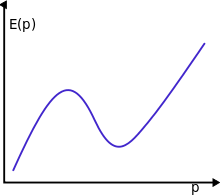Roton
In theoretical physics, a roton is an elementary excitation, or quasiparticle, seen in superfluid helium-4 and Bose-Einstein condensates with long-range dipolar interactions or spin-orbit coupling. The dispersion relation of elementary excitations in this superfluid shows a linear increase from the origin, but exhibits first a maximum and then a minimum in energy as the momentum increases. Excitations with momenta in the linear region are called phonons; those with momenta close to the minimum are called rotons. Excitations with momenta near the maximum are called maxons.

The term "roton" is also used for the quantized eigenmode of a freely rotating molecule.
Models
Originally, the roton spectrum was phenomenologically introduced by Lev Landau. Currently there exist different models which try to explain the roton spectrum, with different degrees of success and fundamentality.[1][2] The requirement for any model of this kind is that it must explain not only the shape of the spectrum itself but also other related observables, such as the speed of sound and structure factor of superfluid helium-4. Microwave and Bragg spectroscopy has been conducted on helium to study the roton spectrum.[3]
Bose–Einstein condensation
Bose–Einstein condensation of rotons has been also proposed and studied.[4] Its first detection has been reported in 2018.[5] Under specific conditions the roton minimum gives rise to a crystal solid-like structure called the supersolid, as shown in experiments from 2019[6].
See also
References
- "Fingerprinting Rotons in a Dipolar Condensate: Super-Poissonian Peak in the Atom-Number Fluctuations". Phys. Rev. Lett. 110: 265302. 26 June 2013. arXiv:1304.3605. Bibcode:2013PhRvL.110z5302B. doi:10.1103/PhysRevLett.110.265302.
- "Roton spectroscopy in a harmonically trapped dipolar Bose–Einstein condensate". Phys. Rev. A. 86: 021604. Aug 15, 2012. arXiv:1206.2770. Bibcode:2012PhRvA..86b1604B. doi:10.1103/PhysRevA.86.021604.
- "Microwave Spectroscopy of Condensed Helium at the Roton Frequency". Journal of Low Temperature Physics. 4 Nov 2009. Bibcode:2010JLTP..158..244R. doi:10.1007/s10909-009-0025-6.
- "The role of the condensate in the existence of phonons and rotons". Journal of Low Temperature Physics. December 1993. Bibcode:1993JLTP...93..861G. doi:10.1007/BF00692035.
- Chomaz, L. (2018). "Observation of roton mode population in a dipolar quantum gas". Nature Physics. arXiv:1705.06914. Bibcode:2018NatPh..14..442C. doi:10.1038/s41567-018-0054-7.
- Donner, Tobias (2019-04-03). "Dipolar Quantum Gases go Supersolid". Physics. 12.